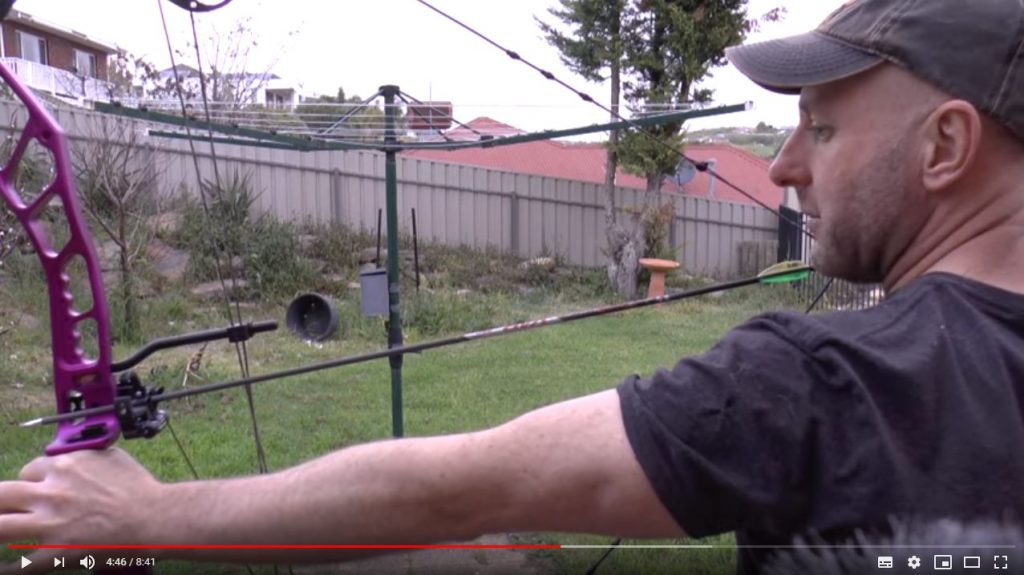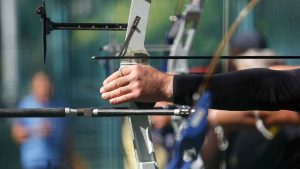Few items in archery are of as much importance, in proportion to their size, as an arrow nock. A nock is an arrow’s lifeline to the bowstring that propels it. The attachment between the two, by proxy, is just as important as the nock itself.
Through this attachment, tremendous amounts of kinetic energy are transferred, facilitating the flight of an arrow that we all find so much enjoyment in.
Contents (Jump to Topic)
A notch or groove at the end of an arrow into which the bowstring fits is usually referred to as the arrow nock.
Nocking an arrow is a simple, but immensely important task that every archer must become proficient at. To Nock an arrow, you must position the arrow in line with your rest and gently couple the nock with its designated placement on your bowstring.
When properly nocked, you should feel, and potentially hear, the nock click firmly into place. A secondary visual check will also yield reassurance to the proper completion of the task at hand.
How To Nock An Arrow On A Bow
Although nocking an arrow is generally a simple task to complete, there is much more to the overall process than what it would outwardly appear.
The act of nocking an arrow is characterized by lining an arrow up with a bow’s rest, then sliding it rearward until the nock fully engages the bowstring.
There are a few subtle differences that pertain to nocking an arrow when using a compound bow versus a recurve bow. Compound bows typically feature a d-loop that is intended for use with a release aid.
The upper and lower knot of this d-loop, as coupled with the bowstring, serves as a dual nock locator. Your arrow is to be nocked in the void between these two knots. When shooting a recurve bow, it is typical to only have a single nock locator. An arrow is nocked directly below this visual aid when preparing to shoot.
Compound Bows typically feature a d-loop
Recurve Bows typically only have a single nock locator
Safety is also a must when nocking an arrow. Remember, nocking an arrow is no different than loading a gun. When an arrow is nocked, anything downrange can be in harm’s way once your bow is drawn.
Therefore, it is imperative to be aware of your surroundings at all times before commencing to nock an arrow. If someone is downrange from your position, Do Not, Under Any Circumstances, Nock An Arrow.
It is also important to inspect your nocks from time to time as a general safety protocol. With time nocks can become worn out and cracked. Nocks in this condition become a safety hazard.
If at any time, a nock shows any cracking or fails to clasp securely to the bowstring, discard it and install a new nock.
Nock Locator
A nock locator is a visual aid that can be placed on a bowstring in a way that makes the consistent nocking of an arrow possible. The most common form of knock locator comes in a metal bead variety that crimps onto the bowstring at the point in which the arrow is to be nocked.
Alternatively, a nock locator can be tied out of serving string material directly onto a bowstring in an identical location. Either of these options makes an adequate source of guidance when seeking to nock an arrow consistently.
Nocking Point
To utilize any form of nock locator, you must first determine where the locator must be placed. To determine this placement, you must adequately decipher your nocking point. This is done with the assistance of a T-square.
This T-square is laid across the bow’s arrow rest horizontally in a manner that intersects the bowstring. You will then place your nock locator at a point that is approximately ½ inch above this point of intersection.
How To Nock An Arrow Quickly
The key to being able to nock an arrow quickly is to shoot and shoot often. Like any task that you wish to become well versed in, repetition is the key to your success when gaining proficiency in arrow nocking.
With each shot, your speed when nocking an arrow will begin to progress. If you first learn to nock an arrow properly, speed will be sure to follow.
How To Remove A Broken Nock From An Arrow
It is extremely common for nocks to become broken during prolonged periods of use. Nocks can crack due to normal wear and tear, or can become damaged due to the impact of one arrow colliding with another in a target.
To remove your old nock, the use of a pair of pliers is highly advised. Gentle twisting pressure should be applied while pulling outward on the knock. This will usually free the nock with little difficulty.
However, if it does not, or the nock is broken to the extent that it cannot be grabbed with pliers, it can be broken into smaller segments and dug from the arrow shaft with the assistance of a small pick.
How To Nock An Arrow If You Are Left Handed
If you are left-handed, you will, of course, prefer to use your dominant hand to nock your arrow. You always hold the grip of the bow with your non-dominant hand and draw with your other hand.
In the case of a left-handed shooter, you would hold the bow’s grip with your right hand, and draw the bowstring with your left. This would mean that your left hand would be left free for use when nocking an arrow.
On all compound bows, and some recurve bows, both right and left-handed models are designated. This is determined by which side of the riser that the arrow shelf, or riser cutout in the case of a compound bow, is located.
This will determine the side of the bow in which you will nock your arrow.
How To Knock An Arrow With A Drop Away Rest
When nocking an arrow in conjunction with a drop away arrow rest, the overall sequence is relatively similar to any other time that an arrow is nocked. The main difference, in this case, is that the arrow does not ride in the rest until the bow is drawn.
Instead, the arrow is laid across the arrow shelf and on top of the disengaged arrow rest assembly.
When the bow is drawn, tension is put on a cable that is routed to the bow’s buss cables, thereby engaging the rest and locking it into place in an upright position.

Other models of drop away rests, however, can be manually locked into place with the use of a thumb tab located on the body of the rest. In this case, once the arrow is knocked, the rest is raised into the upward position, therefore capturing the arrow in place within.
Nocked For Success
Archery success begins the minute that your nock engages the bowstring. In knowing this, you must ensure that this first step in the shooting process is seen to with the utmost attention to detail.
Through diligent practice, proficiency is assured.
As always, feel free to leave us any comments that you might have. We enjoy hearing from our readers.
FAQ
What Does It Mean To Nock An Arrow?
Nocking an arrow is the act of engaging an arrow’s nock onto a bowstring at a designated point. This takes place as archers ready themselves for an impending shot. This procedure is vastly important as it lays the groundwork for the shot that is to come and prevents mistakes such as accidental dryfire caused by the untimely loss of an arrow.
Do You Nock Or Notch An Arrow?
The words nock and notch are commonly confused, though they can mean vastly different things. The correct terminology as it applies to this situation is nock. When you state that you are nocking an arrow, this signifies that you are engaging an arrow’s nock onto a bowstring.
Where Do You Nock An Arrow On A String?
An arrow is to be knocked at your predetermined nocking point or just below your nock locator. If such a visual aid has not been installed on your bow, a quick measurement can yield the information that is needed to install one yourself.
By laying a T-square across your arrow rest in a horizontal manner, a point of intersection between the T-square and your bowstring will become evident. You will then measure approximately ½ inch above this point of intersection, and place a nock locator of your preference.






